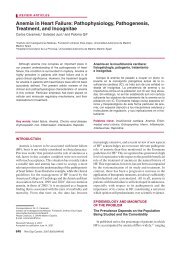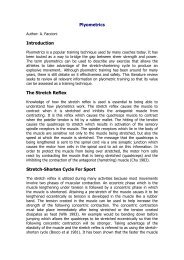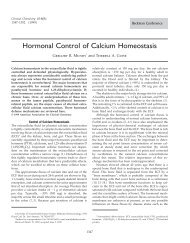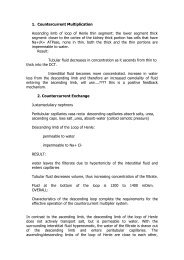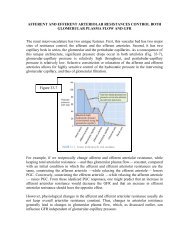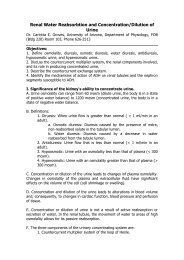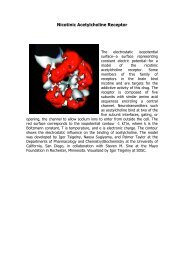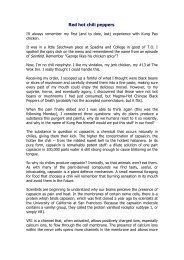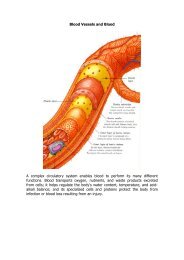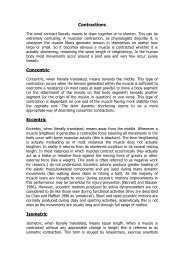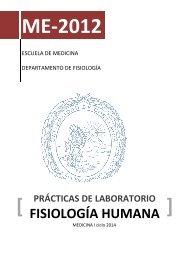Role of Gastrointestinal Hormones in the Proliferation of Normal and ...
Role of Gastrointestinal Hormones in the Proliferation of Normal and ...
Role of Gastrointestinal Hormones in the Proliferation of Normal and ...
Create successful ePaper yourself
Turn your PDF publications into a flip-book with our unique Google optimized e-Paper software.
Thomas et al. • <strong>Gastro<strong>in</strong>test<strong>in</strong>al</strong> <strong>Hormones</strong> <strong>and</strong> <strong>Proliferation</strong> Endocr<strong>in</strong>e Reviews, October 2003, 24(5):571–599 587overexpress<strong>in</strong>g progastr<strong>in</strong> compared with wild-type mice <strong>and</strong>mice overexpress<strong>in</strong>g G-17. Progastr<strong>in</strong>-overexpress<strong>in</strong>g mice displayed<strong>in</strong>creased tumor formation <strong>and</strong> mitogenic <strong>in</strong>dices comparedwith both wild-type <strong>and</strong> G-17-overexpress<strong>in</strong>g mice.Recently, Siddheshwar et al. (266) found that progastr<strong>in</strong>, <strong>and</strong> notG-17, was elevated <strong>in</strong> patients with colorectal cancer <strong>and</strong> dysplasticpolyps, thus provid<strong>in</strong>g cl<strong>in</strong>ical support for <strong>the</strong> importance<strong>of</strong> nonamidated gastr<strong>in</strong>s.Most recently, <strong>the</strong> identification <strong>of</strong> a constitutively activevariant <strong>of</strong> <strong>the</strong> gastr<strong>in</strong>/CCK-B receptor is provid<strong>in</strong>g novel<strong>in</strong>sight <strong>in</strong>to fur<strong>the</strong>r effects <strong>of</strong> gastr<strong>in</strong> <strong>in</strong> <strong>the</strong> proliferation <strong>of</strong>colorectal cancers. Hellmich et al. (271) identified a CCK-Breceptor splice variant that is expressed only <strong>in</strong> colorectalcancers but not <strong>in</strong> normal colonic mucosa adjacent to <strong>the</strong>cancer. This splice variant exhibits constitutive (lig<strong>and</strong><strong>in</strong>dependent)activation <strong>of</strong> pathways regulat<strong>in</strong>g <strong>in</strong>tracellular-freecalcium <strong>and</strong> cell growth. Primary cultures <strong>of</strong> cellsisolated from resected colorectal cancers exhibited spontaneous,lig<strong>and</strong>-<strong>in</strong>dependent oscillatory <strong>in</strong>creases <strong>in</strong> <strong>in</strong>tracellularcalcium, with an <strong>in</strong>crease <strong>in</strong> <strong>in</strong>tracellular calcium notedwith <strong>the</strong> addition <strong>of</strong> G-17. Selective CCK-B receptor antagonistsblocked <strong>the</strong> G-17-stimulated calcium stimulation butnot <strong>the</strong> spontaneous <strong>in</strong>tracellular calcium oscillations. Cellsexpress<strong>in</strong>g <strong>the</strong> CCK-B receptor splice variant exhibited an<strong>in</strong>creased growth rate <strong>in</strong> <strong>the</strong> absence <strong>of</strong> G-17 compared withcells stably transfected with <strong>the</strong> wild-type CCK-B receptor.The selective pattern <strong>of</strong> expression, <strong>the</strong> constitutive activity<strong>and</strong> trophic action associated with this CCK-B receptor splicevariant suggested that this novel variant may regulate colorectalcancer cell proliferation through a gastr<strong>in</strong>-<strong>in</strong>dependentmechanism. This splice variant has recently been identified<strong>in</strong> pancreatic cancers, suggest<strong>in</strong>g that expression may not belimited to colorectal cancer (272).In addition to gastr<strong>in</strong>, NT stimulates growth <strong>of</strong> certa<strong>in</strong>human colon cancer cell l<strong>in</strong>es both <strong>in</strong> vitro <strong>and</strong> <strong>in</strong> vivo (273,274). Yosh<strong>in</strong>aga et al. (273) demonstrated that adm<strong>in</strong>istration<strong>of</strong> NT (ei<strong>the</strong>r 300 or 600 g/kg, three times daily for 21 d)significantly stimulated mean tumor area, weight, <strong>and</strong> DNA,RNA, <strong>and</strong> prote<strong>in</strong> content <strong>of</strong> <strong>the</strong> mur<strong>in</strong>e colon cancer, MC-26.In addition, <strong>the</strong> survival rate <strong>of</strong> mice bear<strong>in</strong>g MC-26 tumors<strong>and</strong> treated with NT was significantly decreased comparedwith <strong>the</strong> control group. Similarly, NT stimulated growth <strong>of</strong><strong>the</strong> human colon cancer, LoVo. We have shown that approximately25% <strong>of</strong> colon cancers analyzed express NT mRNA(274). An autocr<strong>in</strong>e effect for NT <strong>in</strong> certa<strong>in</strong> colorectal cancersis postulated on <strong>the</strong> basis <strong>of</strong> NT expression <strong>in</strong> four colorectalcancer cell l<strong>in</strong>es (LoVo, HT29, HCT-116, <strong>and</strong> CBS), one <strong>of</strong>n<strong>in</strong>e cancer xenografts, <strong>and</strong> two <strong>of</strong> six freshly resected coloncancers; NT expression was not identified <strong>in</strong> <strong>the</strong> adjacentnormal colonic tissue. NT peptide was detected <strong>in</strong> LoVo,HT29, <strong>and</strong> HCT-116 extracts; <strong>and</strong> NTR expression was demonstrated<strong>in</strong> HT29 <strong>and</strong> HCT-116 cells. In a study by Rovereet al. (275), all 13 human colon cancer cell l<strong>in</strong>es displayed lowto moderate levels <strong>of</strong> pro-NT/neuromed<strong>in</strong> N prote<strong>in</strong> expression.Only six <strong>of</strong> <strong>the</strong>se 13 tumors, however, processed <strong>the</strong>precursor to produce NT <strong>and</strong> larger precursor fragmentsend<strong>in</strong>g with <strong>the</strong> NT or neuromed<strong>in</strong> N sequence. Similar to<strong>the</strong> signal<strong>in</strong>g pathways mediat<strong>in</strong>g <strong>the</strong> effects <strong>of</strong> NT <strong>in</strong> pancreaticcancers, Ehlers et al. (276) have shown that NT treatment<strong>of</strong> <strong>the</strong> human colon cancer cell l<strong>in</strong>e KM20, whichexpresses high levels <strong>of</strong> <strong>the</strong> NTR, results <strong>in</strong> calcium mobilizationas well as activation <strong>of</strong> <strong>the</strong> ERK pathway. Thesef<strong>in</strong>d<strong>in</strong>gs suggest that <strong>the</strong> proliferative effect <strong>of</strong> NT may bethrough <strong>the</strong> ERK stimulatory pathway <strong>and</strong> that, similar togastr<strong>in</strong>, NT may be an autocr<strong>in</strong>e growth factor <strong>in</strong> certa<strong>in</strong>colon cancers. The fact that <strong>in</strong>tralum<strong>in</strong>al fats are <strong>the</strong> mostpotent stimulus for NT release suggests an association between<strong>the</strong> known stimulatory effects <strong>of</strong> fats on colon carc<strong>in</strong>ogenesis<strong>and</strong> hormones, such as NT, which <strong>in</strong>crease coloncancer proliferation.Additionally, NT appears to promote carc<strong>in</strong>ogenesis <strong>in</strong> <strong>the</strong>colon <strong>of</strong> rats. Tatsuta et al. (184) reported that rats given10 weekly <strong>in</strong>jections <strong>of</strong> azoxymethane (7.4 mg/kg), as well asNT (200 g/kg every o<strong>the</strong>r day for 40 wk), displayed significant<strong>in</strong>creases <strong>in</strong> <strong>the</strong> number <strong>and</strong> size <strong>of</strong> colon tumors,with a higher degree <strong>of</strong> submucosal penetration. This wascontrasted by <strong>the</strong> fact that NT alone did not <strong>in</strong>crease <strong>the</strong>overall <strong>in</strong>cidence <strong>of</strong> colonic tumors <strong>in</strong> rats. NT caused asignificant <strong>in</strong>crease <strong>in</strong> tumor cell modification above that <strong>of</strong>normal colonic mucosa.Similar to f<strong>in</strong>d<strong>in</strong>gs <strong>in</strong> gastric <strong>and</strong> pancreatic cancers, somatostat<strong>in</strong>has been shown to <strong>in</strong>hibit growth <strong>of</strong> certa<strong>in</strong> humancolon cancers (65–67). Our laboratory has found that <strong>the</strong>somatostat<strong>in</strong> analog, MK-678, significantly <strong>in</strong>hibited growth<strong>of</strong> human colon cancer xenografts (RIP <strong>and</strong> DRUM) (277).One mechanism may be due to <strong>in</strong>hibition <strong>of</strong> gastr<strong>in</strong> release,which is fur<strong>the</strong>r supported by <strong>the</strong> demonstration that adm<strong>in</strong>istration<strong>of</strong> octreotide blocked gastr<strong>in</strong>-<strong>in</strong>duced stimulation<strong>of</strong> <strong>the</strong> MC-26 colon cancer cell l<strong>in</strong>e (65). Melen-Muchaet al. (278) have demonstrated that octreotide <strong>in</strong>hibits proliferation,as measured by BrdU, <strong>and</strong> <strong>in</strong>creases apoptosis, asassessed by <strong>in</strong>creased nuclear DNA fragmentation. Octreotidedecreases <strong>the</strong> proliferation/apoptosis ratio <strong>in</strong> favor <strong>of</strong>cell death <strong>in</strong> Colon 38 transplanted tumors <strong>in</strong> mice. Inhibition<strong>of</strong> colorectal cancer growth with somatostat<strong>in</strong> analogs hasnot been demonstrated <strong>in</strong> all cancer cell l<strong>in</strong>es. di Paolo et al.(67) found that <strong>the</strong> somatostat<strong>in</strong> analog, SMS 201-995, <strong>in</strong>hibitedgrowth <strong>of</strong> SW480 colon cancer cells, but failed to alter<strong>the</strong> growth <strong>of</strong> SW620 cells. However, SW620 cells were sensitiveto SMS 201-995 when used <strong>in</strong> comb<strong>in</strong>ation with IL-1 or<strong>in</strong>terferon-. These results suggest <strong>the</strong> existence <strong>of</strong> differentsomatostat<strong>in</strong> receptor subtypes, which may account for differentialeffects <strong>of</strong> somatostat<strong>in</strong> analogs <strong>in</strong> colorectal cancercells. A recent study has found that l<strong>in</strong>k<strong>in</strong>g toxic chemo<strong>the</strong>rapeuticagents to somatostat<strong>in</strong> analogs that selectively b<strong>in</strong>dto somatostat<strong>in</strong> receptor subtypes can direct chemo<strong>the</strong>rapeuticagents <strong>and</strong> provide more efficient delivery <strong>of</strong> cytotoxicagents to colorectal tumors (279).D. O<strong>the</strong>r cancersGI hormones have been shown to play trophic roles <strong>in</strong> neoplasmsoutside <strong>the</strong> GI tract as well. Notable examples <strong>in</strong>cludebreast, lung, <strong>and</strong> prostate cancers <strong>and</strong> neuroblastomas.1. Breast cancer. In 2002, <strong>of</strong> <strong>the</strong> 647,000 new cases <strong>of</strong> canceraffect<strong>in</strong>g women <strong>in</strong> <strong>the</strong> United States, almost one third werebreast cancers, mak<strong>in</strong>g breast cancer <strong>the</strong> most prevalent canceramong women (249). Hormonal <strong>the</strong>rapy, with antiestrogenagents such as tamoxifen, is an important adjuvant agentDownloaded from edrv.endojournals.org by on July 16, 2007



